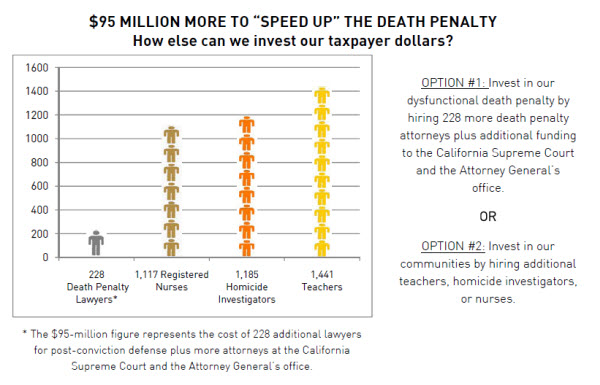 Are Yolo County’s efforts to impose a death sentence on Marco Topete, when his now three-year-old case comes to trial again next month, running up against a strong current against the death penalty?
Are Yolo County’s efforts to impose a death sentence on Marco Topete, when his now three-year-old case comes to trial again next month, running up against a strong current against the death penalty?
Last week, the ACLU reported that just three death sentences were handed down in California from January to June 2011 compared with the same period last year when there were 13.
“California’s death penalty is dead. The signs are clear: Prosecutors are moving towards life imprisonment with no chance of parole over the legal fiction that is California’s death penalty,” said Natasha Minsker, ACLU of California’s Death Penalty Policy Director. “New polls and election results also show that voters favor replacing the death penalty with permanent imprisonment, with a requirement for work and restitution paid to the Victims’ Compensation Fund.”
A 2011 poll by David Binder Research found 63% of likely California voters support converting death sentences to permanent imprisonment. The proposal received support across political party lines and all regions of the state, including a majority of Democrats, Independents, and Republicans.
The ACLU released the report as the California legislature considers SB 490, a bill that would ask voters whether to replace the state’s broken death penalty with life in prison with no chance of parole. The Assembly Public Safety Committee would hear testimony and vote on SB 490 on the morning of Thursday, July 7.
“In the last five years California has spent $700 million on the death penalty and in the next five years we will spend $1 billion more – unless we decide to save our limited state resources and use them for schools, law enforcement and to investigate violent crimes,” added Ms. Minsker.
According to an LA Times Editorial from last month, “Time and again, academic studies have demonstrated that California’s death penalty is a staggering waste of taxpayer money, a legal fiction that gives voters the impression they’re being tough on crime even though condemned inmates typically expire of natural causes before making it to the death chamber.”
The report argues that while California’s death penalty is “costly, wasteful, and harmful for families,” it is “rarely” deadly. In other words, people simply are not being executed. No one has been executed since 2006 and only 13 since 1978.
Mr. Topete’s attorney argued that the wait plus the unlikelihood of execution made it unconstitutional to try Mr. Topete for a capital offense. Judge Richardson rejected that argument, however there is a strong argument to be made that this is simply a waste of money.
According to a new cost study by U.S. 9th Circuit Judge Arthur Alarcon and Loyola Law School Professor Paula Mitchell, death penalty trials cost up to 20 times more than trials for life imprisonment without the possibility of parole.
Data suggest that “the least expensive” capital punishment trial costs $1.1 million more than the most expensive life-without-parole case.
Jury selection is particularly lengthy and expensive, and the state pays up to $300,000 for a defendant’s attorney and security.
In fact, there were six weeks of jury selection in the Topete case, death qualifying jurors, and the jury was not even impaneled when Mr. Topete’s attorney fell ill and the process may have to start all over again.
“I watch today as Gov. Brown wrestles with the massive debt that is suffocating our state and hear him say he doesn’t want to ‘play games.’ But I cringe when I learn that not playing games amounts to cuts to kindergarten, cuts to universities, cuts to people with special needs — and I hear no mention of the simple cut that would save hundreds of millions of dollars, countless man-hours, unimaginable court time and years of emotional torture for victim’s family members waiting for that magical sense of ‘closure’ they’ve been falsely promised with death sentences that will never be carried out,” wrote retired Orange County Superior Court Judge Donald A. McCartin in a March LA Times op-ed.

The report notes that the idea of speeding up the death penalty is a non-starter.
“In 2008, the non-partisan California Commission on the Fair Administration of Justice (CCFAJ) found that California remains at risk of executing an innocent person despite the outlay of hundreds of millions of dollars a year to administer the death penalty.”
The CCFAJ also looked at what could be done to prevent the execution of innocent people while also making the death penalty process move more quickly. The report recommended “a series of reforms and concluded that in order to increase the pace of review of death penalty cases without decreasing the quality of justice, the state would have to spend an additional $95 million a year.”
Another study reached a similar conclusion.
The report argues that “California has not executed anyone since 2006 and there is no reason to believe that executions will ever resume.”
“In 2006, U.S. District Judge Jeremy Fogel ruled that California had to halt executions and revise its lethal injection methods to avoid the risk of unconstitutional and botched executions,” they report. “The California Department of Corrections and Rehabilitation (CDCR) changed its protocols – belatedly and despite nearly 30,000 public comments in opposition – but the new procedures remain tied up in state and federal court challenges.”
However, the problem now is that the state has no legal way to get the drugs that are required for executions.
The report also argues that 46 percent of the state’s homicides go unsolved.
As a Los Angeles Times reader put it: “We need to ask whether we would rather pay for lawyers in the courtrooms or teachers in the classrooms; more prison cells on death row or more police officers on our streets; and more execution drugs or more staff to solve our crimes.”
The California DOJ puts the numbers of murders from 2005 to 2009 at 11,357. Of those, only 6224 of those murders were solved and only 107 of them resulted in death sentences, and of course, none of those people have been executed.
Writes the report, “That leaves 45% of murders unsolved or approximately 5,000 murders, with families left with no justice at all, and the killers walking the streets free. More and more cuts to law enforcement budgets leave little hope that these cases will ever be solved.”
Indeed, in Yolo County, they have enough resources to try to Marco Topete for the death penalty over a three-year period for costs likely exceeding $1 million, but they do not have the resources to bring Martin Ventura and his wife Rosie back to the US to rightfully charge them for the murder of Jesus Cortez Heredia.
Instead, they brought the more accessible Jesus Solis to trial where the jury hung, and when it appeared they could not get a conviction, they dropped the charges.
The report argues that without the death penalty, more resources would exist for law enforcement to solve those 46% of all murders, including perhaps the murder of Mr. Heredia that has quietly been allowed to sit unresolved.
Could they solve Mr. Heredia’s murder with more resources and the ability to extradite two individuals from Mexico? We may never know.
As for the death penalty, advocates now clearly are smelling the possibility to end it.
Said the ACLU’s Death Penalty Analyst, Natasha Minsker, “For years, experts like retired Chief Justice Ron George have declared that California’s death penalty is on the verge of collapse. In fact, the system has already collapsed. It’s time to end this expensive charade. Life in prison with no possibility of parole is a better solution that keeps us safe and saves us money.”
—David M. Greenwald reporting





[quote]The report argues that without the death penalty more resources would exist for law enforcement to solve those 46% of all murders including perhaps the murder of Mr. Heredia that has quietly been allowed to sit unresolved. [/quote]
I’m a proponent of doing away with the death penalty, but even I think this is a stretch to claim more murders will somehow be solved it we do away w the death penalty…
“I’m a proponent of doing away with the death penalty, but even I think this is a stretch to claim more murders will somehow be solved it we do away w the death penalty…”
Do you believe that law enforcement has sufficient resources to solve murders at the present time?
David, it seems that most of the $$ spent on implementing the death penalty have to do with incarceration and legal expenses of trials and appeals. It’s a nice thought that these funds would somehow get redirected to solving unsolved crimes, but the issue (for me) is how to get the $$ to the cops.
[quote]Do you believe that law enforcement has sufficient resources to solve murders at the present time?[/quote]
Now there is an interesting question… not sure I am qualified to even give an answer, but I would probably say “no” to your question. The basis of my conclusion would be that IMHO, anytime DNA is involved in a crime scene, it should be tested as a matter of course. I don’t think this is necessarily done in every state/crime bc it is just too expensive. If I were to guess, lab tests and so forth are very expensive and done on a limited basis. Just my “educated” guess and only a guess…
However, the $1 million (per year?) saved will hardly make a dent in crime solving, when spread over 60 counties, since we are talking about less than $17,000 per county (and it wouldn’t be distributed evenly, so Yolo County would probably end up with almost none of that largesse). I wonder how many DNA tests $17,000 would pay for? Be interesting to know…
Elaine: “However, the $1 million (per year?) saved will hardly make a dent in crime solving, when spread over 60 counties, since we are talking about less than $17,000 per county (and it wouldn’t be distributed evenly, so Yolo County would probably end up with almost none of that largesse). I wonder how many DNA tests $17,000 would pay for? Be interesting to know…”
But the amount of money we are talking about on a yearly basis statewide is a lot more than that.
Robert: Good point, the question is how money from the general fund would be spent that is currently going to corrections to specifically pay for the death penalty. If your answer is that it will remain in corrections, and you are probably correct, then you raise a good point. On the other hand, I still think these comparisons are necessary because in the end, we have to make the decision to fund one thing over another, it’s helpful to understand the consequences of these choices.